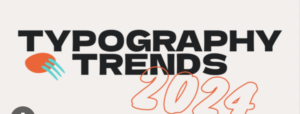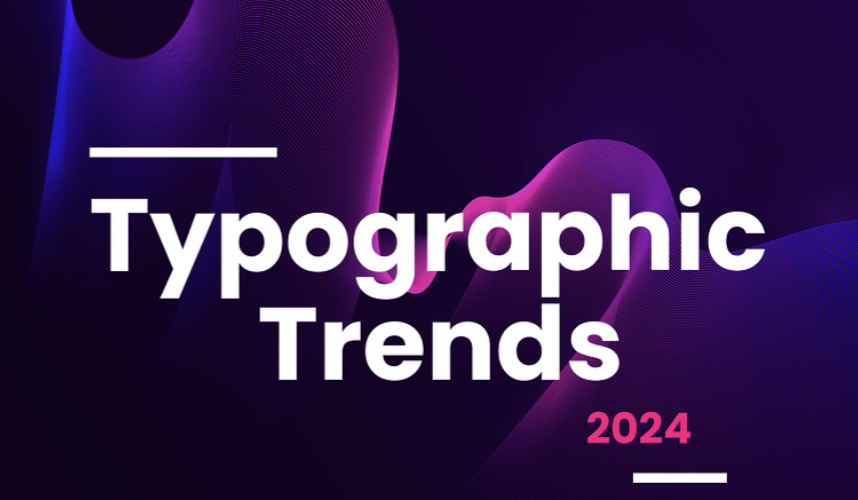In the ever-evolving world of design, typography plays a crucial role in creating visually appealing and effective communication. Fonts have the power to convey emotions, enhance brand identity, and captivate audiences. As we approach the year 2024, it becomes essential for designers and typographers to stay ahead of the curve by being aware of the emerging font trends. This article will explore the font trends that are set to make waves in 2024, providing valuable insights and inspiration for designers seeking to elevate their work.

Font Trends 2024
The importance of staying ahead in typography
Typography is not merely about selecting a font; it is an art form that requires an understanding of aesthetics, legibility, and the ability to communicate effectively. Staying ahead in typography means being aware of the latest trends and techniques, allowing designers to create designs that are fresh, modern, and visually appealing. By staying ahead, designers can differentiate themselves from the competition, attract clients, and maintain a competitive edge in the market.
The impact of font trends on branding and design
Font trends have a profound impact on branding and design. The typography used in a brand’s logo, website, or marketing materials can influence how a brand is perceived by its target audience. For example, a bold and modern font may convey a sense of innovation and cutting-edge technology, while a sleek and elegant script font may evoke a sense of luxury and sophistication. By keeping up with font trends, designers can ensure that their designs align with the brand’s identity and resonate with its target audience.
Key factors influencing font trends in 2024
Several key factors are expected to influence font trends in 2024. One of the significant factors is technological advancements, such as the increased use of augmented reality and virtual reality. These emerging technologies call for fonts that are legible and visually appealing in digital environments. Additionally, societal changes, such as the growing emphasis on sustainability and diversity, are likely to influence font trends. Designers can expect to see a rise in eco-friendly and inclusive fonts that cater to a more socially conscious audience.
Another crucial factor is the desire for uniqueness and personalization. As consumers become more discerning, brands are seeking to stand out by adopting custom fonts that reflect their individuality. This trend towards custom typography allows brands to create a distinct visual identity and establish a stronger connection with their target audience. Designers should anticipate an increased demand for custom font solutions and be prepared to create unique typographic experiences.
Emerging font trends for 2024: a closer look
Variable fonts
Variable fonts have been gaining popularity in recent years, and their prominence is set to continue in 2024. These fonts allow designers to have greater control over the weight, width, and other attributes of the typeface, enabling a more flexible and adaptable design approach. Variable fonts offer versatility, efficiency, and improved performance in digital environments, making them a valuable addition to any designer’s toolkit.
Geometric and modular fonts
Clean lines and geometric shapes have always been a staple in design, and this trend will continue to dominate in 2024. Geometric and modular fonts bring a sense of order and simplicity to designs, making them suitable for a wide range of applications. These fonts are characterized by their minimalistic and structured forms, making them ideal for brands looking to convey a sense of modernity and sophistication.
Handwritten and script fonts
In contrast to the clean and structured nature of geometric fonts, handwritten and script fonts offer a more organic and human touch. These fonts add a sense of warmth, personality, and authenticity to designs, making them perfect for brands that want to create a personal connection with their audience. Handwritten and script fonts can evoke emotions and convey a sense of creativity and individuality.
Experimental and artistic fonts
As designers continue to push boundaries and explore new possibilities, experimental and artistic fonts are expected to gain traction in 2024. These fonts challenge traditional typographic norms and offer unique and visually striking options for designers seeking to create designs that stand out. From distorted and abstract letterforms to unconventional arrangements, experimental and artistic fonts provide an opportunity for designers to unleash their creativity and create designs that leave a lasting impression.
How to incorporate font trends into your designs
Incorporating font trends into your designs requires a thoughtful and strategic approach. Here are some tips to help you seamlessly integrate font trends into your work:
Research and inspiration
Stay informed about the latest font trends by conducting research and seeking inspiration from reputable design sources. Explore design blogs, attend design conferences, and follow influential designers on social media platforms to stay up-to-date with the latest trends and techniques. By immersing yourself in the design community, you can gain valuable insights and find inspiration for incorporating font trends into your designs.
Understand the brand and audience
Before selecting a font, it is crucial to understand the brand and its target audience. Consider the brand’s personality, values, and positioning, and identify the characteristics that the font should convey. Additionally, analyze the target audience and their preferences to ensure that the selected font resonates with them. By aligning the font with the brand and audience, you can create designs that are not only visually appealing but also effective in communicating the intended message.
Experiment and iterate
Font selection is a creative process that requires experimentation and iteration. Don’t be afraid to explore different font options and combinations to find the perfect fit for your design. Experiment with various font weights, sizes, and styles to achieve the desired visual impact. Iterate on your designs, seeking feedback from colleagues or clients, and refine your choices until you achieve the desired result. The process of experimentation and iteration is essential for creating designs that are both aesthetically pleasing and effective in conveying the intended message.
Tools and resources for exploring and implementing font trends
To explore and implement font trends effectively, designers can leverage a range of tools and resources. Here are some valuable resources that can assist in staying up-to-date and incorporating font trends into your designs:
Font libraries and marketplaces
Font libraries and marketplaces offer an extensive collection of fonts that designers can explore and utilize in their projects. Websites like Google Fonts, Adobe Fonts, and MyFonts provide a wide range of free and premium fonts, making it easy to find fonts that align with the latest trends. These platforms often provide advanced search and filtering options, allowing designers to discover fonts based on specific criteria such as style, weight, and language support.
Design software and plugins
Design software such as Adobe Creative Cloud and Sketch offer a variety of tools and plugins that streamline the process of exploring and implementing font trends. These software solutions provide extensive font libraries, advanced typography controls, and features for experimenting with font styles and combinations. Additionally, there are plugins available that offer additional functionality and customization options, enabling designers to create unique typographic experiences.
Online design communities and forums
Online design communities and forums provide a platform for designers to connect, share knowledge, and seek inspiration. Websites like Behance, Dribbble, and Reddit have vibrant design communities where designers can showcase their work, participate in discussions, and learn from each other. Engaging with these communities can provide valuable insights into font trends, as well as opportunities for collaboration and feedback on your designs.
Case studies: Successful use of font trends in design
Examining real-world examples of successful font trends implementation can provide valuable inspiration and insights. Here are two case studies showcasing how font trends were effectively incorporated into design:
Case Study 1: Brand X – Bold and modern typography
Brand X, a technology startup, wanted to convey a sense of innovation and forward-thinking through their branding. They opted for a bold and modern typography approach, using a variable font with a wide range of weights to create visual impact and versatility. The font’s clean lines and geometric forms reflected the brand’s commitment to simplicity and efficiency. By incorporating this font trend, Brand X was able to establish a modern and cutting-edge identity that resonated with their target audience.
Case Study 2: Brand Y – Handwritten and script fonts
Brand Y, a boutique coffee shop, aimed to create a warm and welcoming atmosphere for their customers. They chose handwritten and script fonts to convey a sense of authenticity and personal touch. The fonts’ organic shapes and flowing forms added a human element to their branding, reflecting the brand’s commitment to personalized customer experiences. By embracing this font trend, Brand Y was able to create a unique and memorable visual identity that set them apart from their competitors.
Future-proofing your typography skills
As font trends continue to evolve, it is crucial for designers to future-proof their typography skills. Here are some strategies to stay ahead and ensure your skills remain relevant:
Continuous learning and professional development
The field of typography is constantly evolving, and it is essential for designers to engage in continuous learning and professional development. Attend workshops, webinars, and conferences to stay updated with the latest trends, techniques, and best practices. Additionally, consider enrolling in typography courses or pursuing certifications to enhance your skills and knowledge. By investing in your professional development, you can stay ahead of the curve and remain competitive in the industry.
Collaborate and network
Collaboration and networking are invaluable for staying informed about font trends and expanding your skill set. Engage with other designers, typographers, and professionals in the design industry to exchange ideas, share insights, and learn from each other. Collaborative projects and discussions can provide fresh perspectives and expose you to new approaches to typography. By building a strong professional network, you can stay connected to the design community and stay informed about the latest font trends.
Embrace experimentation and creativity
To future-proof your typography skills, embrace experimentation and creativity. Don’t be afraid to step outside your comfort zone and explore unconventional approaches to typography. Push the boundaries, challenge traditional norms, and experiment with new techniques and tools. By embracing a mindset of continuous experimentation and creativity, you can adapt to emerging font trends and create designs that are innovative and visually captivating.
Conclusion and final thoughts on font trends for 2024
As we look ahead to 2024, it becomes clear that font trends will continue to shape the world of design and typography. Staying ahead of these trends is essential for designers seeking to create impactful and visually appealing designs. By understanding the key factors influencing font trends, exploring emerging trends, and incorporating them thoughtfully into designs, designers can elevate their work and stay ahead of the curve.
Remember, font trends are not just about following the latest fads; they are about effectively communicating brand messages, eliciting emotions, and creating memorable experiences. By combining research, strategic thinking, and creative experimentation, designers can harness the power of font trends to craft designs that captivate audiences and make a lasting impact.

